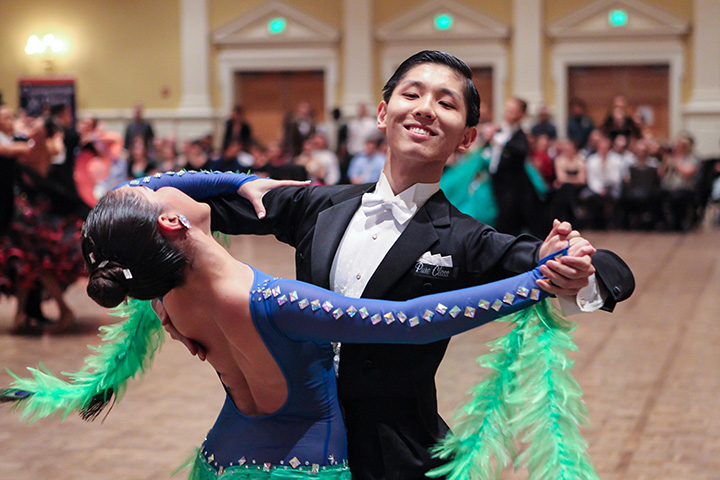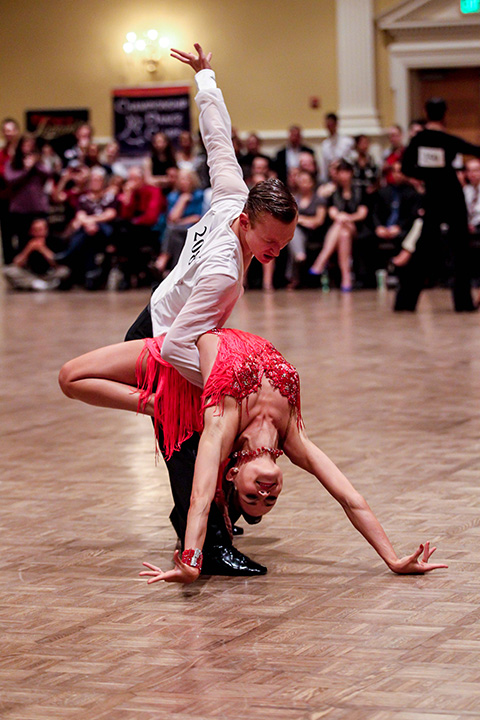It was a fairy tale in an Olympic arena.
University alumnus Alec Zhang lightly grasped his partner’s palm and rested his other hand on the small of her back. Long green feathers from his partner’s dress draped over his uplifted arms. The two swirled around the room as one, seeming to take flight in a fusion of graceful, intricate movements. Light from the chandeliers illuminated the rapture on Zhang’s face — he was singing along.
“Previously, I played a musical instrument,” Zhang said after the dance. “Dancing allows me another way to express music.”
This weekend, Stamp Student Union’s Grand Ballroom was transformed into another world — a glittering, fantastical world of dancing couples. More than 850 ballroom dancers from about 50 schools arrived for the annual D.C. Dancesport Inferno competition, hosted by Ballroom at Maryland, this university’s ballroom dance team.
The three-day competition was essentially a “giant fundraiser” for the ballroom team, according to club president and senior government and politics and history major Ilene Friedman. Although most participants were college students, the competition was open to anyone. Dancers as young as 10 and as old as 60 competed in everything from traditional waltzes to sensual, high-energy sambas.
Their one unifying feature? A love of dance and the insanity that defines the ballroom community — something not even Hurricane Sandy could conquer.
Eric Karnani, a senior at New York University and interim president of his school’s ballroom club, hopped on a Bolt bus Friday night to make it to the competition.
“We jumped on a bus at 8 in the evening last night after all the power was half-restored and we came here, and we got like four hours of sleep, and we got up, and we rocked it today,” Karnani said, twirling his hands and bubbling with energy.
The competition features four styles of dance — rhythm, standard, smooth and Latin — and 19 different dances. Within each, there are four different levels of dance, each of which is allowed only certain movements. These are all written out in a giant rule book called the “syllabus.”
Friedman does not deny the craziness of ballroom dance. In fact, she embraces it.
“The first thing they told me when I joined was, ‘This is a cult,’” Friedman said. “And it totally is. It absorbs your entire life.”
Ballroom at Maryland first began in 1994 with six members, and the team has since grown to 100 members, Friedman said. Each week, the club offers free classes to anyone who shows up. Members range from those who come once every three weeks to those like Friedman who practice almost every day.
“Right now, I’m studying for LSATs, but when I’m not studying for LSATs, I practice two to three hours a day, six days a week,” Friedman said. “Which is not normal … I’m just crazy.”
Most club members are actually engineering or science majors, Friedman said. Thomas Winkler, a bioengineering graduate student, said dancing gives his life balance.
“It’s a nice way to relax and let go and think about something completely different from research,” Winkler said. He and his partner won sixth place in the foxtrot competition Saturday.
Friedman said dancing helps members become more self-confident in their daily lives.
“You learn patience beyond anything,” she said. “You learn to work with a team, and it’s a team with your partner. It’s fun. You learn how to adapt. You have to learn to trust someone else. And if you see someone going through the levels, you gain so much confidence.”
Long, sparkling dresses twirled on the dance floor in a rainbow of colors Saturday. One particularly tall dancer galloped across the floor with his partner. “See him? We call him the giraffe,” said Ian Wong, a graduate medical student at Case Western Reserve University. Everyone in the ballroom community knows each other, he said.
“You train with them,” Wong said. “It’s a friendly rivalry.”
During the competition, partners stared deeply into each other’s eyes, their faces just inches apart. Partnership is integral, Friedman said.
“Everything is about focusing on your partner,” she said. “If they say do a move that’s not in your routine, do it, because maybe you’re dodging somebody. It’s honestly bumper cars. You’re going to run into other people.”
It’s difficult not to. During the competition, couples flew around the dance floor so fast they sometimes could not avoid hitting one another or even one of the 13 judges lined up around the edges of the floor, scribbling on clipboards. In judges’ scoring, being hit by a dancer could be a major factor, Friedman said.
“If you ran into them on accident and did not apologize, they will probably not mark you back. I’m not kidding,” she said. “If they don’t like your hair, they won’t mark you back. If they don’t like your dress, they won’t mark you back.”
Ballroom at Maryland has a “trial period” for new partners, to see if they can move well together, she said.
However, she added one does not necessarily have to like one’s partner in order to dance well with them.
“Some people hate each other, but love dancing more,” Friedman said. “This one couple, they danced insanely well together, but they had to sign a non-verbal contract that they wouldn’t fight.”
Others, however, get along well — so well they decide to spend the rest of their lives together. Chen Ling, 34, who joined Ballroom at Maryland as a student in 1999, said his randomly assigned dance partner later became his wife.
“While I was here, Jen, my wife, was dancing with a guy named Hose,” Ling said. “He was a weird guy. They would compete, the music would stop, and he’d just walk off and leave her on the floor. We’re like, ‘What is wrong with you? You’re supposed to escort the lady off the floor.’ So that didn’t last very long.”
However, Ling also had to go through several partners before finding the right one.
“The first time I did merengue — this was my first fiancee, which is perhaps why she’s not still my fiancee — I was trying to move my hips right, be the awkward guy doing hip motions,” Ling said. “She started giggling for five minutes and wouldn’t stop. And I was like, ‘I’m not doing this again, ever.’”
No matter how one feels about partners, Friedman said trust is key.
“The more you dance, the more you feel like each other,” she said.
On Saturday, the dancing went on past midnight, but dancers were back in the ballroom at 7 the next morning, ready to begin again. As the night grew later Saturday, the packed ballroom only became more crowded. Despite the 40-degree temperature outside, the heat inside in the ballroom was palpable. The cheers were louder, the competition thicker. Steps were more difficult; one dancer began in a full split on the ground. Another danced sensually up her partner’s body.
“It is awesome,” Ling said of the dancing. “It has a life of its own.”
University alumnus Alec Zhang dances with his partner in the D.C. Dancesport Inferno, which overtook Stamp Student Union this weekend as 850 dancers from about 50 schools came to compete.
Ballroom dancers compete during the annual D.C. Dancesport Inferno competition in Stamp Student Union, hosted by Ballroom at Maryland.
Dancers as young as 10 and as old as 60 competed in everything from traditional waltzes to sensual, high-energy sambas in this weekend’s ballroom dancing competition at Stamp Student Union.






